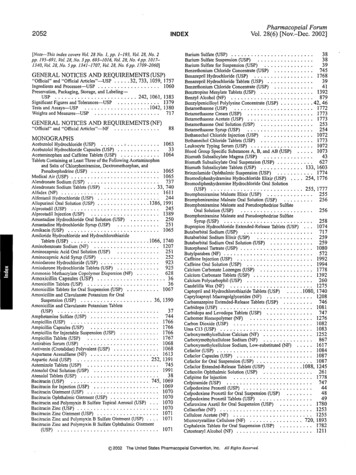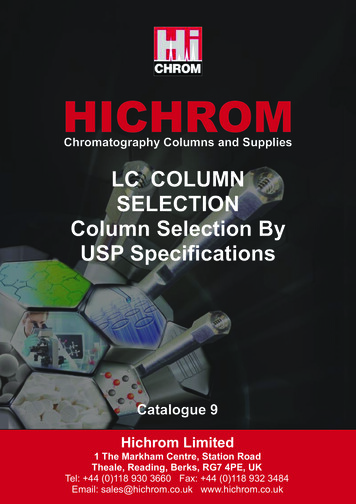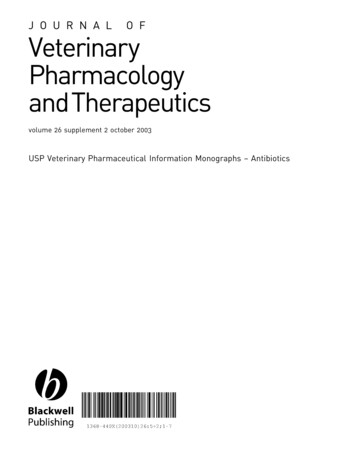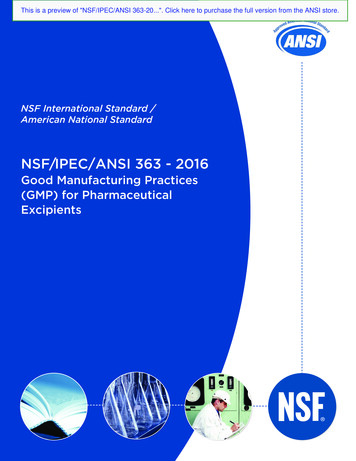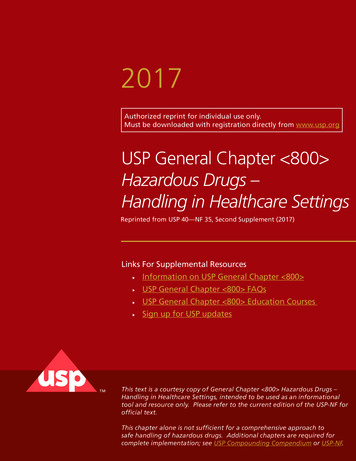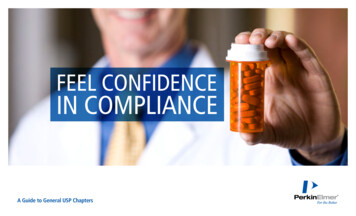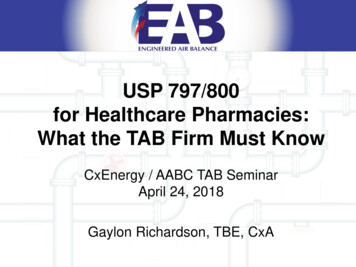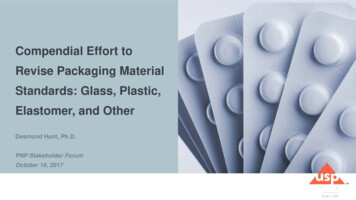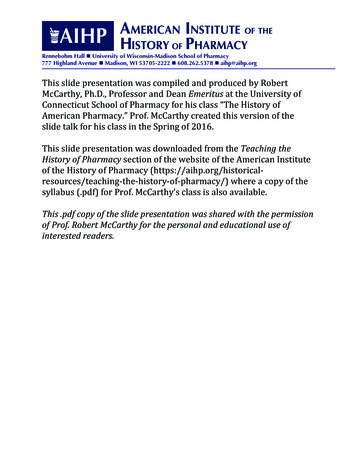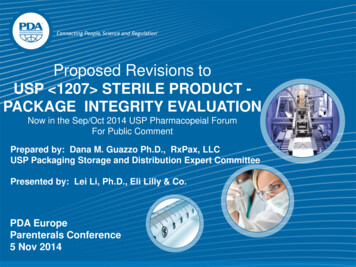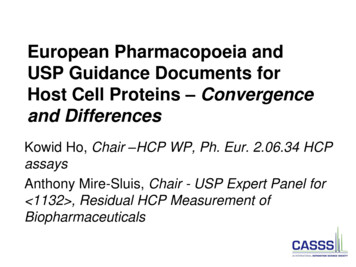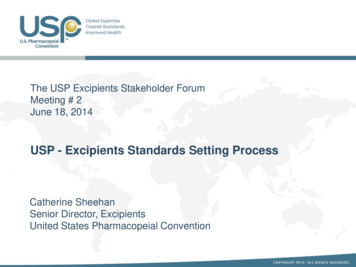
Transcription
The USP Excipients Stakeholder ForumMeeting # 2June 18, 2014USP - Excipients Standards Setting ProcessCatherine SheehanSenior Director, ExcipientsUnited States Pharmacopeial Convention
Standards Established through a Public Process USPcreates and continuously revises USP–NF standardsthrough a unique public–private collaborative process Thisinvolves pharmaceutical scientists in industry, academia, andgovernment as well as other interested parties from anywhere inthe world. Publicinput and interaction are vital to the development of thesestandards. Thestandards generally originate from sponsors who providedraft standards and supporting data to either create new or revise(modernization) existing monographs and general chapters.
Types of USP Standards Monographs(Vertical Standards)– Specifications for pharmaceutical articles in commerce– Specifications – Tests, assays and acceptance criteria needed todemonstrate the article meets required quality standards GeneralChapters (Horizontal Standards)– Required (numbered 1000)– Informational (numbered 1000)– Support monographs by centralizing methods and procedures PhysicalReference Standards Materials– Provide traceable standards to demonstrate broad-based acceptability ofprocedures
General Notices, General Chapters, andMonographs GeneralNotices contain requirements applicable throughoutUSP NF unless superseded by a chapter or monograph GeneralChapters contain requirements applicable to monographsto which they apply– General Chapter requirements supersede General Notice requirements incase of conflict Monographrequirements are specific to the monograph in whichthey appear– Monograph requirements supersede General Notice and General Chapterrequirements in case of conflict
USP-NF Monographs Twotypes of monographs:– Official Substances– Including bulk drugs and excipients– Official Products TheUSP contains monographs for Official Products and OfficialSubstances that are mainly classified as bulk drugs TheNF contains monographs for Official Substances that aremainly classified as excipients. Somegrey areas, e.g:– Atypical actives (dual actives)5
The Objective of a USP-NF Excipient Monograph Safety– We do not want to harm the patient Identity– We want to make sure we are using the correct material and grade.– Using the wrong grade or even the wrong excipient may cause harm tothe patient, e.g. dose dumping of an extended release product.– Absence of e.g. adulterants and contaminants. ‘Purity’– For Excipients this means the absence of harmful and/or other undesirablecomponents.6
USP-NF General ChaptersThere are three types of General Chapters in the USP-NF: GeneralChapters 1000– These are mandatory when applicable. GeneralInformation Chapter 1000 – 1999– These are not mandatory unless they are specifically referenced in amonograph in which case they become mandatory for that monograph. DietarySupplement General Chapters 2000– Only applicable to dietary supplements.7
Standards Established through a Public Process USP'sscientific staff and volunteer experts review a request forrevision to the USP-NF, conduct laboratory tests (if necessary),and forward the new or revised monograph or general chapterto Pharmacopeial Forum (PF) for public review and comment. PFis free, online only resource. http://www.usp.org/uspnf/pharmacopeial-forum Thepublic process helps to refine USP standards for publicationas official text in the USP–NF. Priorto publication as official text, all monograph and generalchapter proposals must be approved by a USP Expert Committee. Comprisedof volunteer scientists, academicians, practitioners,and other professionals elected on the basis of their knowledgeand expertise.
Expert Panels and Stakeholder Forums Expert Panels— The Chair of the Council of Experts may appoint Expert Panelsto assist the Council of Experts by providing advisory recommendations toparticular Expert Committees in response to a specific charge consistent withthe Expert Committee's Work Plan. Expert Panels are continuously formed. Stakeholder Forums and Project Teams— USP has formed several domesticand international Stakeholder Forums and Project Teams to exchangeinformation on the use and implementation of USP's standards. StakeholderForums may form Project Teams to work on selected topics.–––North American Stakeholder Forums (United States and Canada) Prescription/Nonprescription Dietary Supplements Excipients Food Ingredients Veterinary DrugsInternational Stakeholder Forums India Mexico Brazil OthersUSP also conducts Science and Standards Symposia in the United States, India, China, LatinAmerica, Middle East/North Africa, and in other regions of the world.10
Monographs – Excipient Expert Committee (EXCEC) 2010-2015 CycleMonographs – Excipient Expert Committee (EXC)Total of 12 SubcommitteesEXC A(158 monographs)EXC B(121 monographs)EXC C(117monographs)EXC PharmacopeialDiscussion Group D - KEXC Cross CuttingGeneral ChaptersArea of Waxes,PlantsEXCD(Cellulosics)EXC EEXC EXCG(Povidones)EXC KEXC H(starchesEXC I(sweetners)EXC relatedGeneralchapters
Pharmaceutical Excipients – DEFINITION* PharmaceuticalExcipients—Pharmaceutical excipients aresubstances other than the active pharmaceutical ingredient (API)that have been appropriately evaluated for safety and areintentionally included in a drug delivery system. For example,excipients can do the following:– aid in the processing of the drug delivery system during its manufacture,– protect, support, or enhance stability, bioavailability, or patient acceptability,– assist in product identification, and– enhance any attribute of the overall safety– assist in the effectiveness and/or delivery of the drug in use– assist in maintaining the integrity of the drug product during storage* Modified from USP General Information Chapter, 1078 Good ManufacturingPractices for Bulk Pharmaceutical Excipients
USP–NF Revision Process Commentary––In cases where proposals advance to official status without republication in PF, a summary ofcomments received and the appropriate Expert Committee's responses are published in theCommentary section of the USP website at the time the revision is published.The Commentary is not part of the official text and is not intended to be enforceable byregulatory authorities. Rather, it explains the basis of the Expert Committee's response to13public comments.
Excipient Compendial Testing and ExcipientPerformanceThe emphasis of compendial tests for an excipient relate to Specifications forIdentity, Quality and PurityICH Guidelines Q6A and Q6B – Specifications (Tests, Procedures andAcceptance Criteria)Tests for some (but not all) physical and chemical properties of the materialSpecificationsUniversal TestsOptional Tests(Performance RelatedTests)Specific TestsIdentificationpHAssayLoss on DryingOr otherImpuritiesMicrobial LimitsDescriptionBacterialEndotoxin(Reference Tables)
General Notices 4.10. MONOGRAPHS ANDGENERAL CHAPTERS15
USP-NF Excipient Monograph layout Title Definition––Contains a chemical definition with content limits, or describes the substance and the source(s)from which it is obtained. It may also refer to the method of manufacture.Any permitted additives will also be indicated. Identification Assay Other Components Impurities Specific Tests Additional Requirements––– Packaging and StorageLabelingUSP Reference StandardsNote: Not every excipient monograph will contain every section16
Examples of Definitions for Excipients from USPNF DibasicCalcium Phosphate Dihydrate USP– Dibasic Calcium Phosphate Dihydrate contains two molecules of water ofhydration. It contains NLT 98.0% and NMT 105.0% of dibasic calciumphosphate dihydrate (CaHPO4·2H2O) OliveOil NF– Olive Oil is the refined fixed oil obtained from the ripe fruit of Olea europaeaLinné (Fam. Oleaceae). It may contain suitable antioxidants MicrocrystallineCellulose NF– Microcrystalline Cellulose is purified, partially depolymerized celluloseprepared by treating alpha cellulose, obtained as a pulp from fibrous plantmaterial, with mineral acids.17
Identification Tests in the USP-NF Traditionallythese have been ‘wet’ chemistry tests relating to colorchanges, solubility, or precipitation. Notall ID tests are specific for the particular molecule NFmonographs include instrumental methods such as:– Infra Red spectroscopy– Chromatographic peak retention time NFmonographs can have physical tests– Degree of substitution (based on intrinsic viscosity) Wherepossible, USP is moving to more reliable instrumentalmethods. Wherenecessary USP will be including compound-specific testsin monograph (to help combat intentional adulteration).18
Assays in USP-NF Excipient monographs Notall NF excipient monographs have assays.– e.g. Microcrystalline Cellulose, Polyethylene Oxide. Notall assays are specific for the nominal component.– e.g. 461 Kjeldahl Nitrogen Determination for nitrogen-containing excipients,– e.g. Povidone USPis looking to develop/obtain more specific assays for thoseexcipients that do not have them.19
Other components/Impurities In general, most excipients are not ‘pure’ due to presence of “othercomponents” (sometimes referred to as Concomitant Components) thatcan be classified as:– Desirable (Functional) They contribute to excipient performance and do not present a safety concern(e.g. additives/processing aids with a limit (Gen. Notices 5.20. AddedSubstances )– Acceptable They do not present a safety concern. However, both the USP-NF and FDA categorize Impurities as– Inorganic ( 281 Residue on Ignition)– Organic ( 466 Ordinary Impurities)– Residual solvents ( 467 Residual Solvents)20
Additional Requirements Packagingand Storage– More specific instructions will be introduced for some excipients. Labeling– Specific details required to be included on the label or labeling. USPReference Standards– A list of USP Reference Standards required to complete all the tests includedin the monograph.21
What a USP-NF Excipient Monograph does notcontain Appearance Solubility Performancetests, except where they are required for e.g. gradedifferentiation– However, the intent is to differentiate between different grades of the sameexcipients, not to assess performance per se.– Performance requirements are application-specific, and there is no way apharmacopeia monograph can cover all applications.– Performance assessment is for the excipient user, and perhaps the excipientmanufacturer.22
Where to Put Performance TestsIn the context of the Pharmacopeias we have two options: Inthe monograph– In a Labeling Section– In a ‘non-mandatory’ Section Ina General Information Chapter– Detailing tests that might be appropriate when excipients are used for aparticular purpose.– Listing the appropriate tests for each material.
Concerns Thereis a range of opinion regarding the benefit of includingadditional performance based testing of excipients intopharmacopeias. A majorconcern revolves around unnecessary testing that may be“required” by:– Uninformed excipient users requesting unnecessary testing from suppliers– Regulatory agencies requiring unnecessary testing because it is in themonograph
1059 Excipient Performance, how can thePharmacopeia help? Byproviding guidance as to which properties might be importantfor a particular material in a particular application. Byproviding standard methods that can be used by bothmanufacturers and users:– Makes communication more straightforward– Avoids an unnecessary plethora of test variations for a particular parameter. Bykeeping the tests non-mandatory. Byavoiding confusion with mandatory tests and labeling tests. Bynot imposing limits/specifications. Providesa framework for applying Quality by Design concept toexcipient quality control.– As an important component of drug products, variation in excipientperformance characteristics may affect critical quality attributes and processparameters of drug products, and the robustness of manufacturing process25
NF New Monograph Development ss Regulatory status (e.g, permitted for use in an FDA regulated drugproduct marketed in the US ) Rationale (for revisions) Proposed tests, procedures and acceptance criteria– Identification test(s)– Impurity test(s)– Assay test (preferably stability-indicating) Validation data Packaging, storage, and labeling requirements Reference Standard commitments–Statement on suitability for use of any existing USP ReferenceStandards–Commitment to provide candidate materials for new USP standards
Monograph Development Typicaltime line: 18 to 24 months from submission to officaladoptions but it can take longer Impactedby– Review/evaluation of public comments– Obtaining additional information– Publishing/republishing responses– Testing in USP’s Laboratory– Availability of reference materials Resource MonographSubmission Guideline– Monograph Submission Guideline it-new-monographs/submission-guidelines– USP Guideline for Submitting Requests for Revision to USP-NF . Excipients- Chapter 3– http://www.usp.org/sites/default/files/usp pdf/EN/USPNF/chapter3.pdf
NF monographs can have physical tests -Degree of substitution (based on intrinsic viscosity) Where possible, USP is moving to more reliable instrumental methods. Where necessary USP will be including compound-specific tests in monograph (to help combat intentional adulteration). Identification Tests in the USP-NF . 18
